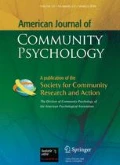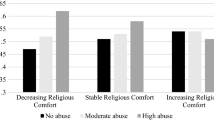Abstract
Surveyed two high school cohorts (ns=698 and 283) to study independent prospective predictors of adolescent suicidal behaviors (thoughts, communicatio to others, attempts). Within each cohort, there were two measurements conducted 6 months apart. Structural equation models were tested, with depressive symptoms, hopelessness, alcohol consumption, social support, and gender serving as predictors. In the larger cohort, depression predicted later levels of all three suicidal behaviors controlling for baseline suicidal behaviors. Also, suicidal thoughts predicted later communications, and suicide attempts predicted future thoughts. In the smaller cohort, alcohol consumption predicted all three suicidal behaviors at the later measurement, whereas depression was predictive only of later thoughts. Major issues regarding prevention, theories of suicide and negative affect, and methodological/analytical approaches were discussed.
Similar content being viewed by others
References
Abramson, L. Y., Metalsky, G. I., & Alloy, L. B. (1989). Hopelessness depression: A theory-based subtype of depression.Psychological Review, 96, 358–372.
Armor, D. J., & Polich, J. M. (1982). Measurement of alcohol consumption. In E. M. Pattison & E. Kaufman (Eds.),Encyclopedic handbook of alcoholism (pp. 72–81). New York: Gardner.
Barnes, G. M., Welte, J. W., & Dintcheff, B. A. (1993). Decline in alcohol use among 7–12th grade students in New York State, 1983–1990.Alcoholism: Clinical and Experimental Research, 17, 797–801.
Barrera, M., Chassin, L., & Rogosch, F. (1993). Effects of social support and conflict on adolescent children of alcoholic and nonalcoholic fathers.Journal of Personality and Social Psychology, 64, 602–612.
Baumeister, R. F. (1990). Suicide as escape from self.Psychological Review, 97 90–113.
Beck, A. T. (1963). Thinking and depression: I. Idiosyncratic content and cognitive distortions.Archives of General Psychiatry, 9, 324–333.
Beck, A. T., Brown, G., Berchick, R. J., Stewart, B. L., & Steer, R. A. (1990). Relationship between hopelessness and ultimate suicide: A replication with psychiatric outpatients.American Journal of Psychiatry, 147, 190–195.
Bentler, P. M. (1989).EQS structural equations program manual. Los Angeles: BMDP Statistical Software.
Berman, A. L., & Jobes, D. A. (1991).Adolescent suicide: Assessment and intervention. Washington, DC: American Psychological Association.
Berndt, T. J. (1992). Friendship and friends' influence in abdolescence.Current Directions in Psychological Science, 1, 156–159
Bolger, N., & Eckenrode, J. (1991). Social relationships, personality, and anxiety during a major stressful event.Journal of Personality and Social Psychology, 61, 440–449.
Browne, M. W. (1984). Asymptotically distribution-free methods for the analysis of covariance structures.British Journal of Mathematical and Statistical Psychology, 37, 62–83.
Cohen, S., & Wills, T. A. (1985). Stress, social support, and the buffering hypothesis.Psychological Bulletin, 98, 310–357.
Cole, D. A. (1988). Hopelessness, social desirability, depression, and parasuicide in two college student samples.Journal of Consulting and Clinical Psychology, 56, 131–136.
Cole, D. A. (1989). Psychopathology of adolescent suicide: Hopelessness, coping beliefs, and depression.Journal of Abnormal Psychology, 98, 248–255.
Crumley, F. E. (1990). Substance abuse and adolescent suicidal behavior.Journal of the American Medical Association, 263, 3051–3056.
Dubow, E. F., Kausch, D. F., Blum, M. C., Reed, J., & Bush, E. (1989). Correlates of suicidal ideation and attempts in a community sample of junior high and high school students.Journal of Clinical Child Psychology, 18, 158–166.
Dunkel-Schetter, C., & Bennett, T. L. (1990). Differentiating the cognitive and behavioral aspects of social support. In B. R. Sarason, I. G. Sarason, & G. R. Pierce (Eds.),Social support: An interactional view (pp. 267–296). New York: Wiley.
Dyer, J. A. T., & Kreitman, N. (1984). Hopelessness, depression and suicidal intent in parasuicide.British Journal of Psychiatry, 144, 127–133.
Felner, R. D., Adan, A. M., & Silverman, M. M. (1992). Risk assessment and prevention of youth suicide in schools and educational contexts. In R. W. Maris, A. L. Berman, J. T. Maltsberger, & R. I. Yufit (Eds.),Assessment and prediction of suicide (pp. 420–447). New York: Guilford.
Felts, W. M., Chenier, T., & Barnes, R. (1992). Drug use and suicide ideation and behavior among North Carolina public school students.American Journal of Public Health, 82, 870–872.
Garland, A. F., & Zigler, E. (1993). Adolescent suicide prevention: Current research and social policy implications.American Psychologist, 48, 169–182.
Garrison, C. Z., McKeown, R. E., Valois, R. F., & Vincent, M. L. (1993). Aggression, substance use, and suicidal behaviors in high school students.American Journal of Public Health, 83, 179–184.
Harkavy-Friedman, J. M., Asnis, G. M., Boeck, M., & DiFiore, J. (1987). Prevalence of specific suicidal behaviors in a high school sample.American Journal of Psychiatry, 144, 1203–1206.
Hawton, K. (1986).Suicide and attempted suicide among children and adolescents, Newbury Park, CA: Sage.
Hull, J. G. (1987). Self-awareness model. In H. T. Blane & K. E. Leonard (Eds.),Psychological theories of drinking and alcoholism (pp. 272–304). New York: Guilford.
Kandel, D. B., Raveis, V. H., & Davies, M. (1991). Suicidal ideation in adolescence: Depression, substance use, and other risk factors.Journal of Youth and Adolescence, 20, 289–309.
Kazdin, A. E., Rodgers, A., & Colbus, D. (1986). The Hopelessness Scale for Children: Psychometric characteristics and concurrent validity.Journal of Consulting and Clinical Psychology, 54, 241–245.
Kinkel, R. J., Bailey, C. W., & Josef, N. C. (1989). Correlates of adolescent suicide attempts: Alienation, drugs and social background.Journal of Alcohol and Drug Education, 34, 85–96.
Lewinsohn, P. M., Rohde, P., & Seeley, J. R. (1994). Psychosocial risk factors for future adolescent suicide attempts.Journal of Consulting and Clinical Psychology, 62, 297–305.
Linehan, M. M., & Nielsen, S. L. (1981). Assessment of suicide ideation and parasuicide: Hopelessness and social desirability.Journal of Consulting and Clinical Psychology, 49, 773–775.
Pfeffer, C. R. (1986).The suicidal child. New York: Guilford.
Procidano, M. E., & Heller, K. (1983). Measures of perceived social support from friends and from family: Three validational studies.American Journal of Community Psychology, 11, 1–24.
Pyszczynski, T., & Greenberg, J. (1987). Self-regulatory perseveration and the depressive self-focusing style: A self-awareness theory of reactive depression.Psychological Bulletin, 102, 122–138.
Radloff, L. S. (1977). The CES-D Scale: A self-report depression scale for research in the general population.Applied Psychological Measurement, 1, 385–401.
Radloff, L. S. (1991). The use of the Center for Epidemiologic Studies Depression Scale in adolescents and young adults.Journal of Youth and Adolescence, 20, 149–166.
Robins, L. N. (1989). Suicide attempts in teen-aged medical patients.Report of the Secretary's Task Force on Youth Suicide: Vol. 4. Strategies for the prevention of youth suicide (DHHS Publication No. ADM 89-1624). Washington, DC: U.S. Government Printing Office.
Rosenthal, R. (1990). How are we doing in soft psychology?American Psychologist, 45, 775–777.
Rudd, M. D. (1990). An integrative model of suicidal ideation.Suicide and Life-Threatening Behavior, 20, 16–30.
Rudd, M. D. (1993). Social support and suicide.Psychological Reports, 72, 201–202.
Sayette, M. A. (1993). An appraisal-disruption model of alcohol's effects on stress responses in social drinkers.Psychological Bulletin 114, 459–476.
Schneider, S. G., Taylor, S. E., Hammen, C., Kemeny, M. E., & Dudley, J. (1991). Factors influencing suicide intent in gay and bisexual suicide ideators: Differing models for men with and without human immunodeficiency virus.Journal of Personality and Social Psychology, 61, 776–788.
Schwarzer, R., & Leppin, A. (1991). Social support and health: A theoretical and empirical overview.Journal of Social and Personal Relationships, 8, 99–127.
SPSS. (1990).SPSS reference guide. Chicago: Author.
Steele, C. M., & Josephs, R. A. (1990). Alcohol myopia: Its prized and dangerous effects.American Psychologist, 45, 921–933.
U.S. Department of Health and Human Services, Public Health Service. (1991).Healthy people 2000: National health promotion and disease prevention objectives. Washington, DC: Author.
Wills, T. A. (1990). Social support and the family. In E. A. Blechman (Ed.),Emotions and the family: For better or for worse (pp. 75–98). Hillsdale, NJ: Erlbaum.
Windle, M. (1992). A longitudinal study of stress buffering for adolescent problem behaviors.Developmental Psychology, 28, 522–530.
Windle, M., Barnes, G. M., & Welte, J. (1989). Causal models of adolescent substance use: An examination of gender differences using distribution-free estimators.Journal of Personality and Social Psychology, 56, 132–142.
Windle, M., & Miller-Tutzauer, C. (1992). Confirmatory factor analysis and concurrent validity of the Perceived Social Support-Family measure among adolescents.Journal of Marriage and the Family, 54, 777–787.
Windle, M., Miller-Tutzauer, C., Barnes, G. M., & Welte, J. (1991). Adolescent perceptions of help-seeking resources for substance abuse.Child Development, 62, 179–189.
Windle, M., Miller-Tutzauer, C., & Domenico, D. (1992). Alcohol use, suicidal behavior, and risky activities among adolescents.Journal of Research on Adolescence 2, 317–330.
Youniss, J., & Haynie, D. L. (1992). Friendship in adolescence.Developmental and Behavioral Pediatrics, 13, 59–66.
Author information
Authors and Affiliations
Additional information
This research was supported by NIAAA Grant AA07861 awarded to Michael Windle. The authors thank the anonymous reviewers for their helpful comments on earlier drafts of the manuscript.
Rights and permissions
About this article
Cite this article
Reifman, A., Windle, M. Adolescent suicidal behaviors as a function of depression, hopelessness, alcohol use, and social support: A longitudinal investigation. Am J Commun Psychol 23, 329–354 (1995). https://doi.org/10.1007/BF02506948
Issue Date:
DOI: https://doi.org/10.1007/BF02506948




